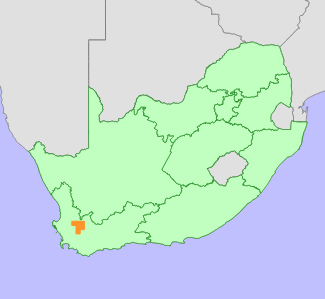|
Scientific Name | Erica caprina E.G.H.Oliv. |
Higher Classification | Dicotyledons |
Family | ERICACEAE |
Synonyms | Grisebachia minutiflora N.E.Br., Grisebachia minutiflora N.E.Br. subsp. minutiflora, not Erica minutiflora Andrews, Grisebachia minutiflora N.E.Br. subsp. nodiflora (N.E.Br.) E.G.H.Oliv., not E.nodiflora Salisb., Grisebachia nodiflora N.E.Br., not Erica nodiflora Salisb. |
National Status |
Status and Criteria | Vulnerable A2bc |
Assessment Date | 2018/10/04 |
Assessor(s) | E.G.H. Oliver, R.C. Turner & L. von Staden |
Justification | Erica caprina has experienced a population reduction of 30% in the past three generations, based on the loss of subpopulations to expanding agriculture in the past 40 years (generation length 15 years). This threat has however largely ceased, as most remaining subpopulations occur in montane areas unsuitable to cultivation. This range-restricted habitat specialist remains at 10-15 locations, with an extent of occurrence (EOO) of 1055 km². It is also potentially threatened by drought, and is therefore listed as Vulnerable under criterion A. |
Distribution |
Endemism | South African endemic |
Provincial distribution | Western Cape |
Range | This species is endemic to South Africa, and is found in Koue Bokkeveld north of Ceres. |
Habitat and Ecology |
Major system | Terrestrial |
Major habitats | Winterhoek Sandstone Fynbos, Cederberg Sandstone Fynbos, Swartruggens Quartzite Fynbos, Kouebokkeveld Alluvium Fynbos |
Description | It occurs in fynbos, sandy, quartzitic plateaus between mountain ranges, 900-1 500 m. |
Threats |
| Habitat transformation for agricultural expansion (mostly orchards, vineyards and onion fields) has claimed at least six known subpopulations on the flats between Gydo Pass and Citrusdal, and habitat loss is ongoing. About 20% of this species' habitat has already been lost. A number of subpopulations however also occur in montane areas where they are not threatened by habitat loss as these sites are unsuitable for agriculture. Some of these montane subpopulations are thought to be potentially threatened by drought due to water extraction from streams. |
Population |
Erica caprina is a range-restricted species preferring a specialized, localized habitat. It is declining on the flats of the Koue Bokkeveld Plateau, where six out of 19 known subpopulations (30%) have been lost to recently expanding crop cultivation since the 1970s and 1980s. Many more recent records are however from montane areas where there is no threat from habitat loss, and out of 11 recently recorded locations, only one is potentially threatened by expanding crop cultivation.
|
Population trend | Decreasing |
Assessment History |
Taxon assessed |
Status and Criteria |
Citation/Red List version | | Erica caprina E.G.H.Oliv. | VU B1ab(ii,iii,iv,v)+2ab(ii,iii,iv,v) | Raimondo et al. (2009) | | Grisebachia minutiflora N.E.Br. subsp. nodiflora (N.E.Br.) E.G.H.Oliv. | Indeterminate | Hilton-Taylor (1996) | |
Bibliography |
Goldblatt, P. and Manning, J.C. 2000. Cape Plants: A conspectus of the Cape Flora of South Africa. Strelitzia 9. National Botanical Institute, Cape Town.
Hilton-Taylor, C. 1996. Red data list of southern African plants. Strelitzia 4. South African National Botanical Institute, Pretoria.
Oliver, E.G.H. 1980. Studies in the Ericoideae. III. The genus Grisebachia. Bothalia 13(1):65-93.
Oliver, E.G.H. 2000. Systematics of Ericeae (Ericaceae-Ericoideae): species with indehiscent and partially indehiscent fruits. Contributions from the Bolus Herbarium 19:1-483.
Raimondo, D., von Staden, L., Foden, W., Victor, J.E., Helme, N.A., Turner, R.C., Kamundi, D.A. and Manyama, P.A. 2009. Red List of South African Plants. Strelitzia 25. South African National Biodiversity Institute, Pretoria.
|
Citation |
| Oliver, E.G.H., Turner, R.C. & von Staden, L. 2018. Erica caprina E.G.H.Oliv. National Assessment: Red List of South African Plants version 2024.1. Accessed on 2025/10/24 |
 Comment on this assessment
Comment on this assessment


